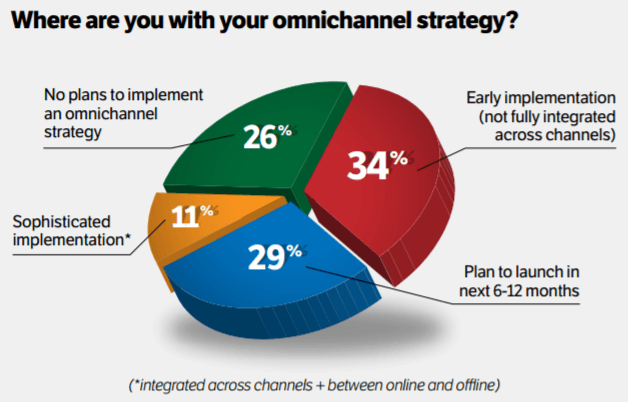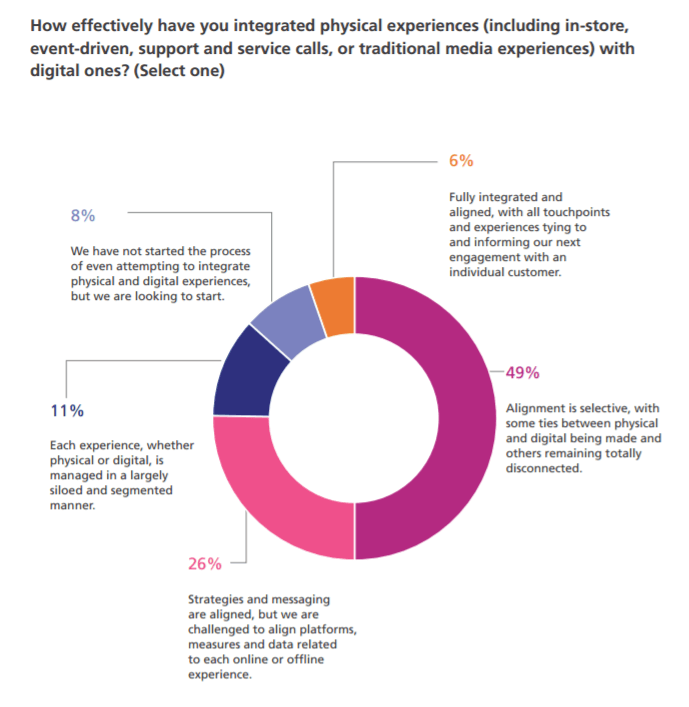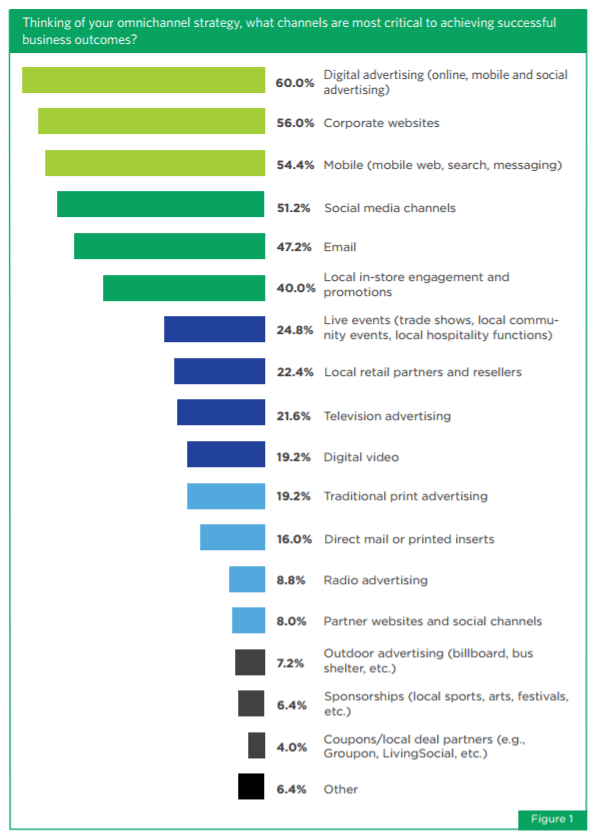Miss Scarlet, in the kitchen, with a mobile device. Professor Plum, in class, with a laptop computer.
It’s like today’s marketers have to play their own version of customer Clue. When the path to purchase can start or end at any time, in any location, on any device, it’s becoming more necessary for businesses to provide a seamless user experience across them all.
According to Google research, 90% of multiple device owners switch between an average of three per day to complete a task. Businesses that can help their customers complete those tasks when and where they want stand to gain a piece of the $1.8 trillion that cross-channel sales are predicted to reach this year.
That’s why, increasingly, companies are guiding their prospects and leads through the customer journey with an omni-channel strategy.
90% of multiple device owners switch between an average of three per day to complete a task.
Click To Tweet
What is omnichannel marketing?
Omnichannel marketing refers to the concept of providing a seamless user experience across all channels relevant to the buyer’s journey. The term emphasizes a shift in the way people progress through the marketing funnel.
In the US, 213 million adults access the internet with an average of 4 different devices. They’re more connected, and they have more control over the buying process than ever before.
What used to be a one or two-stop shop is now a journey that spans days, times, locations, and channels. And those channels aren’t strictly technological ones. They can be newspapers or trade magazines or catalogs in the mail. They can be your storefront, word of mouth, or an outbound ad like a billboard.
When customers can interact with a brand anytime, anywhere, how are businesses preparing to accommodate them? (For more information how to use post-click landing pages at the top of your marketing funnel, check out our guide here.)
Who’s using an omnichannel strategy and how?
To find out, Rakuten Marketing teamed up with the CMO Club in 2015. They surveyed 122 B2B and B2C chief marketing officers on their adoption of the growing technique. According to their responses, 45% had already begun implementing an omnichannel marketing strategy, but only 11% of those considered their efforts “sophisticated.” Of the respondents who had yet to, 29% were in the planning stages and intended to roll one out within 6 to 12 months.

On the flipside, a surprising 26% of respondents said they had no plans to put an omnichannel marketing strategy into effect. Standing in the way of creating one, according to respondents, were the following:
- Lack of resources and investments required to succeed
- Lack of analytical and technical resources to make sense of data
- Difficulty integrating data
- Lack of communication between marketing agencies and/or vendors
- Lack of C-suite buy-in to the value of omni-channel
- Siloed organizational structure
A year later, a survey of 198 marketers by IBM and the CMO Council indicate that challenges remain. However, only 11% of respondents still manage their campaigns in a siloed and unconnected manner.

The rest have already begun, or are planning to begin, implementing an omnichannel marketing strategy by connecting channels and experiences.
Today that’s no surprise, considering joint research from the CMO Council and Netsertive shows that 94% of marketers believe that providing an omni-channel experience is crucial to business success. So what does one look like?
Omnichannel marketing: An example

If the idea of completely overhauling your marketing strategy to create a seamless cross-channel experience sounds overwhelming to you, then start small by building a single, omni-channel campaign that focuses on responding to a customer need, like the team at the Camuto Group did.
The trench coat above was a big hit with Camuto’s customers, but there was one problem: The communications team heard from a retailer that buyers kept losing the belt.
In response, the marketing team launched an omni-channel campaign that spanned email, social, web, and in-store promotions. It featured digital content from three fashion bloggers, “create a trenchlook” sweepstakes, and stylish suggestions to customers.
The campaign exemplifies the value of an omnichannel marketing campaign: It puts the customer at the center of the experience. In this case, it takes a complaint about the product and then uses marketing’s coordination with other departments to create a seamless, cross-channel campaign that solves the problem.
Getting started with omnichannel
Are you planning to create an omnichannel marketing strategy? Here are a few things you’ll need to get started:
1. An emphasis on context
You’ve heard the sickeningly cliche phrase “content is king” more times than you can probably stand. Today that’s still true, but without context, it’s nothing. Lisa Gevelber expands:
With empowered consumers now connecting across an array of devices in a variety of situations, the way a marketer wins is by offering information people value in those moments. It’s not that being relevant is a new concept. But being relevant to the moment is where marketing power — and consumer expectations — now lie.
What kind of content are your customers consuming and when? Are your ebooks resonating with them? Do your free tools better convert customers? At what point in the buyer’s journey do they find them most valuable? Are they optimized for the device that they’re being consumed on?
If you’re a retailer with an omni-channel strategy, are you offering your prospects suggestions based on their browsing history? How about their location? When RadioShack added a mobile optimized store locator with click-to-call and GPS functionality, they estimated that 40-60% then visited a store, with 85% of those making a purchase.
Are you trying to upsell and cross-sell them other offers? Are you sending responsive abandoned cart emails that can be viewed on a myriad of devices?
These are just some examples of a few of the questions you’ll need to answer about your ideal buyer. To get them, you’ll need…
2. Deep knowledge of the customer
To provide a truly valuable omni-channel experience, you have to know your customers intimately. You have to understand who they are and where they’re coming from. You need to know their goals and challenges.
Invite customer feedback, use social listening tools, and leverage the power of lead capture post-click landing pages to learn more about them. Most importantly, which channels do they use to access your content?
The Netsertive report indicates that the following are the channels most crucial to omni-channel success:

Use these as a benchmark, but remember that they may vary based on your business’s audience and buyer personas.
3. Inter-departmental coordination and agility
Takeaways from multiple reports indicate there’s still a major roadblock to omni-channel implementation: siloed organizational structure. Sales, marketing, product development, PR, and customer service still operate somewhat independently of each other in many organizations.
The good news is, that’s changing. Only 11% claim their departments are siloed compared to 26% in 2015. The reason for the change could be that some are completely redefining their teams. An excerpt from the report by Rakuten Marketing and the CMO Club:
At Pet360, Rose Hamilton, Executive Vice President, CMO & General Manager, says redefining and reorganizing teams has helped optimize their omnichannel strategy. The company’s marketing team is now considered a ‘customer engagement team,’ encompassing product development, marketing, CRM, content, social and PR functions. Information Technology (IT) is also part of the team. This allows the technical team to better understand and support marketing efforts, and eliminates the technical barriers cited by survey respondents. ‘What pulls us together is that everyone has a hand in the customer experience,’ Hamilton says.
Restructuring traditional roles can put the responsibility for the customer experience on more than one or two departments, thereby allowing each team to understand how it fits into the omni-channel puzzle in relation to others. That, in turn, sets clear expectations that can streamline communication between teams.
When communication is swift and teams operate fluidly, the result can be what you saw with Camuto Group’s trenchcoat example. Agile marketing that puts customers at the center makes for remarkable omni-channel experiences.
4. A fully integrated marketing technology stack
The marketing technology landscape is bigger and more confusing now than ever. It’s also more necessary now than ever to identify groupings of tools that can work together to improve all facets of your marketing efforts.
When used together, those tools are called a “marketing technology stack.” They’re different for everyone, but research from Aberdeen indicates the most used are:
- Customer relationship management software
- Video/web conferencing solution
- Email service provider
- Marketing automation platform
- Print materials and solutions
- Analytics and data visualizations solutions
- Content management system
At the heart of every productive marketing technology stack is a customer relationship management (CRM) tool that allows you to record, in detail, each buyer’s journey from prospect to customer.
And if the CRM is the heart, then the analytics tool is the brain. Without it, you can’t make any informed decisions about your overall strategy. A report from the CMO Council shows that an organization’s relationship with data directly impacts how they understand user behavior.
Make sure you have both, then build the rest of your stack around them with tools that will allow you to reach your customers relevantly.
5. Responsively designed web pages
Nobody likes to pinch and zoom. With customers accessing your brand’s content on all channels and devices, it needs to display well no matter the screen size. All your web pages should be designed responsively — especially your post-click landing pages — on which visitors will need to input personal information in a form with their thumbs.
Is omnichannel marketing really worth the hassle?
After learning the effort it takes to do omni-channel right, you’re probably asking yourself if it’s worth it. According to several studies, the answer is a confident “yes.”
According to a study from IDC, users who shop across channels have a 30% higher lifetime value than those who do not. Another study of 46,000 shoppers reinforces that, showing customers not only enjoy using multiple channels, but that they also spent…
- an average of 4% more on each shopping occasion in-store.
- 10% more online those who use only one channel.
- 13% more when doing prior research before buying.
The more channels they use, the more valuable they become.
Have you begun creating an omni-channel approach? Do you plan to? What challenges face your organization on its path to seamless cross-channel coordination?
Whatver challenges you face, make sure that each customer touchpoint educates prospects and moves them further along in your funnel. To do that effectively, create a unique and personalized post-click landing page here follow the best practices in the guide below.
